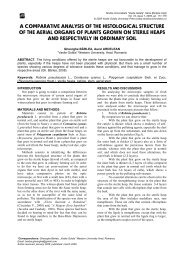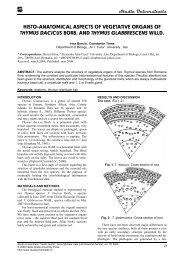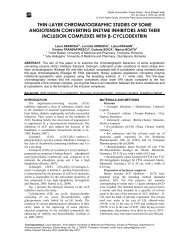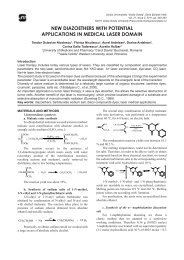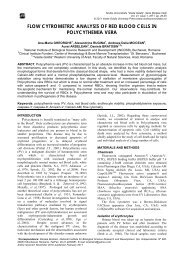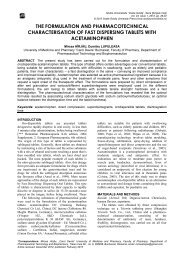euphorbiaceae juss. - Studia Universitatis Vasile Goldis, Seria ...
euphorbiaceae juss. - Studia Universitatis Vasile Goldis, Seria ...
euphorbiaceae juss. - Studia Universitatis Vasile Goldis, Seria ...
Create successful ePaper yourself
Turn your PDF publications into a flip-book with our unique Google optimized e-Paper software.
<strong>Studia</strong> <strong>Universitatis</strong><br />
MORPHOLOGY AND ANATOMY OF THE FRUIT AND SEED IN<br />
DEVELOPMENT OF EUPHORBIA HELIOSCOPIA L.<br />
(EUPHORBIACEAE JUSS.)<br />
Ramona Crina GALEŞ ∗ , Constantin TOMA, Lăcrămioara IVĂNESCU<br />
“Al. I. Cuza” University of Iasi, Faculty of Biology<br />
* Correspondence: Galeş Ramona Crina, Universitatea “Al. I. Cuza”, Faculty of Biology, Department of Biology,<br />
Carol I Bd., no. 20A, 700506, Iaşi, Romania, e-mail: ramonarotari@yahoo.com<br />
Received: april 2008; Published: may 2008<br />
ABSTRACT. The aim of this study is to determine the histo-anatomical peculiarities of the fruit and seed in<br />
development of Euphorbia helioscopia L. with relation to taxonomy and ecology.<br />
Keywords: Euphorbia helioscopia, fruit, seed, development, morphology, anatomy, ecology, taxonomy<br />
INTRODUCTION<br />
Euphorbia helioscopia is an annual invasive weed<br />
that dominates many arable lands from Romania and<br />
relatively little is known about its ontogenesis cycle,<br />
especially from a structural perspective. From<br />
ecological point of view, it is a xerophilous plant, its<br />
vegetation period being very short (Prodan, 1953).<br />
The foreign literature on embryology and carpology<br />
in other Euphorbia species is quit rich. The aim of<br />
these studies is to evidence the cito-histological<br />
features of the ovary and ovule development during<br />
ontogenesis (Raja and Prakasa, 1975; Gori 1987;<br />
Bhanwra, 1987; Carmichael and Selbo, 1999), as well<br />
as to identify the morphological and anatomical<br />
characters with implications in phylogeny, systematic<br />
and ecology of Euphorbia genus (Tokuoka şi Tobe,<br />
1995, 2002; Strasburger, 1998; Chaturvedi and Dalal,<br />
2000; Esser, 2003).<br />
In a recent study (Galeş and Toma, 2008) we<br />
analyzed the development on the vegetative apparatus<br />
in Euphorbia helioscopia, and in this paper we<br />
investigate the morphology and structure of the fruit<br />
and seed during ontogenesis related to the habitat and<br />
pollination type, underlining the histo-anatomical<br />
peculiarities of these organs which serve as elements of<br />
species diagnosis.<br />
MATERIALS AND METHODS<br />
The material represented by mature cyathia, fruits<br />
and seeds of Euphorbia helioscopia, collected from an<br />
arable land from Rădăuţi, Suceava County (Romania),<br />
was fixed in FEEA mixture and preserved in 70%<br />
ethylic alcohol. Fixed samples were dehydrated by a<br />
passage through ethanol/water solutions and then<br />
embedded in paraffin at 65ºC for 24 hours. The<br />
embedded material was cut into 13 µm thick sections<br />
with a rotator microtome. The dried serial sections<br />
were deparaffinized, rehydrated in serial dilutions of<br />
ethanol (100%, 90%, and 70%), coloured with metilenblue<br />
and ruthenium-red, and finally mounted in Canada<br />
balsam.<br />
<strong>Studia</strong> <strong>Universitatis</strong> “<strong>Vasile</strong> Goldiș”, <strong>Seria</strong> Ştiințele Vieţii (Life Sciences Series), vol. 18, 2008<br />
© 2008 <strong>Vasile</strong> <strong>Goldis</strong> University Press<br />
http://www.studiauniversitatis.ro<br />
The permanent slides were analyzed in the light<br />
microscopy, using a Novex (Holland) microscope; the<br />
micro-photos were made at the same microscope with a<br />
Sanyo digital camera.<br />
RESULTS AND DISCUSSIONS<br />
Fruit development (Plate I)<br />
The ovary of the mature female flower of E.<br />
helioscopia cyathium is 3-carpellar, syncarpous, 3-<br />
locullar with central-marginal placentation.<br />
The onelayered outer epidermis of the ovary wall<br />
shows xeromorphous characters, as follows: (1) all<br />
epidermis cells evidence a papilla-shaped prominence<br />
in the middle of the external wall, the latest one being<br />
more thicker then the other walls and covered by<br />
cuticle; (2) the stomata are founded under the external<br />
level of the epidermis, having small guard cells, deep<br />
epistomatal chamber and large substomatal chamber<br />
limited by palisade cells. The ovarian mesophyll is<br />
cellulosic – parenchymatous, relatively compact and<br />
heterogeneous, being composed of a layer with slightly<br />
high cells (immediately under the external epidermis),<br />
4-5 layers of rounded cells (in the central part),<br />
following by a layer of high palisade cells and probably<br />
few layers of tangentially elongated cells, which are<br />
mighty crushed under the internal epidermis (Fig. 1).<br />
The exocarp of the fruit derives from the external<br />
epidermis of the ovary, which does not undergo<br />
significant histological transformations, its component<br />
cells being of papilla-shaped but shorter.<br />
The mesocarp derives from the ovarian mesophyll.<br />
The palisade cells undergo a gradual radially<br />
elongation and their walls become partly lignified. In<br />
the thickness of mesocarp small vascular bundles and<br />
numerous laticifers of variable diameter may be<br />
observed.<br />
During the fruit development, the internal<br />
epidermis is partly disorganized. The endocarp derives<br />
from the subadjacent layers of the internal epidermis<br />
(Fig. 2).<br />
17
<strong>Studia</strong> <strong>Universitatis</strong><br />
As in the majority of the Euphorbia species, the E.<br />
helioscopia fruit is represented by a capsule with<br />
septicidal dorsicidal and septifragal dehiscence, being<br />
adapted for anemochory (Roth, 1977; Strasburger,<br />
1998). During ontogenesis, the fruit has green colour.<br />
In cross-section (Fig. 3), the fruit conserves the<br />
mature ovary shape, being approximately triangular,<br />
with rounded angles. The three large depressions, each<br />
one comprising two vascular bundles, represent the<br />
places of the carpels fusion. The three deep ditches,<br />
each one comprising a single vascular bundle, mark the<br />
median nervure of each carpel. The central part of the<br />
fruit represents the collumela, which comprises three<br />
big vascular bundles.<br />
Outer epidermis<br />
Exocarp<br />
Mesophyll<br />
Mesocarp<br />
Inner epidermis 1<br />
Endocarp 2<br />
Plate I. Fruit development in Euphorbia helioscopia L.<br />
Fig. 1. Cross-section from the mature ovary wall.<br />
Fig. 2. Cross-section from the ovary wall during fruit<br />
development.<br />
Fig. 3 Cross-section from the ovary during fruit<br />
development. (orig. photos., scale bars = 50µm)<br />
3<br />
Seed development (Plate II)<br />
The mature ovule is anatropus, crassinucellar and<br />
bitegmic, having a well-defined nucellar epidermis<br />
with relatively big cells.<br />
Tokuoka and Tobe (1995) suggested that only the<br />
following five of over 50 embryological characters of<br />
ovules and seeds are likely to be useful for comparison<br />
between and within the subfamilies of Euphorbiceae<br />
families: (1) the presence or absence of vascular<br />
bundles in the inner integument; (2) whether the inner<br />
integument is thick or thin; (3) whether ovules or seeds<br />
are pachychalazal or not; (4) whether seeds are arillate<br />
or not; (5) whether an exotegmen is fibrous or not. In<br />
2002, the same authors mentioned that within the<br />
Euphorbiaceae family and also within Euphorbia<br />
genus, there is a morpho-structural diversity of ovules<br />
and seeds, given by three characters: (1) the thickness<br />
of the inner integument, (2) the thickness of the outer<br />
integument, and (3) the presence or absence of an aril.<br />
In our analyzed species, the outer integument of the<br />
ovule is very thin; both onelayered epidermises and the<br />
two parenchymatous layers (only one hear and there)<br />
18<br />
between them consist of small cells. In the micropyllar<br />
region of the ovule, the outer integument is thicker than<br />
in the other parts and some of its cells intensively<br />
proliferate, given born to a caruncle (Fig. 4).<br />
The inner integument is thick and consists of an<br />
external onelayered epidermis with high cells, 5-6<br />
layers of cellulosic-parenchymatous cells and an<br />
onelayered internal epidermis with small and slightly<br />
elongated cells.<br />
An obturator consist of elongated cells derives from<br />
the placenta and penetrates the micropyle and the style<br />
duct, having role in the guidance of the pollen tube<br />
towards the micropyle, after Baillon’s statement (1858)<br />
(cf. Weninger, 1917).<br />
The embryo sac is elongated. After fecundation, the<br />
first divisions of the triploid zygote are not followed<br />
immediately by cytokinesis; thus a secondary nuclear<br />
endosperm results. In this stage of development the<br />
embryo sac shows a parietal layer of cytoplasm (in<br />
which there are nuclei of the secondary endosperm)<br />
and a big central vacuole (Fig. 5). In the embryo region<br />
<strong>Studia</strong> <strong>Universitatis</strong> “<strong>Vasile</strong> Goldiş”, <strong>Seria</strong> Ştiințele Vieţii (Life Sciences Series), vol. 18, 2008<br />
© 2008 <strong>Vasile</strong> <strong>Goldis</strong> University Press<br />
http://www.studiauniversitatis.ro
<strong>Studia</strong> <strong>Universitatis</strong><br />
and in the chalazal end of the endosperm, big<br />
congestions of cytoplasm and nuclei may be observed.<br />
The seed coat (Fig. 6) develops from the two<br />
integuments of the ovules and consists of epidermis,<br />
testa and tegmen.<br />
The epidermis derives from the external epidermis<br />
of the outer integument.<br />
The testa derives from the parenchymatous tissue<br />
and internal epidermis of the outer integument and<br />
external epidermis of the inner integument; the latest<br />
one undergoes visible histological manifestations,<br />
transforming in a horny layer consisted of radially<br />
elongated cells with sclerified and lignified walls.<br />
Beside, Tokuoka şi Tobe (1995) underline, that from<br />
histological point of view, in all the species of<br />
Euphorbiaceae family, the seeds present a palisade<br />
persistent exotegmen, consisted of small radially<br />
elongated cells with sclerified walls.<br />
The tegmen derives from the parenchymatous tissue<br />
and the internal epidermis of the inner integument.<br />
From morphological point of view, the E.<br />
helioscopia seed has oval shape, brown-grey colour<br />
and presents two appendages: (1) a white and very<br />
prominent caruncle and (2) a raphe which appear as a<br />
longitudinal black ridge from the hillum to the chalaza.<br />
The seed surface is reticular, presenting “large<br />
depressions” arranged in longitudinal lines (Figures 7,<br />
8).<br />
Caruncle<br />
Outer integument<br />
Obturator<br />
Micropyle<br />
Inner<br />
integument<br />
Epidermis<br />
Secondary<br />
nuclear<br />
endosperm<br />
4<br />
Nucella<br />
5<br />
Testa<br />
Epidermis<br />
Tegmen<br />
6 7<br />
Plate II. Seed development in Euphorbia helioscopia L.<br />
Fig. 4, 5. Longitudinal sections from the ovule, after<br />
fecundation.<br />
Fig. 6. Cross-section from the seminal tegument.<br />
Fig. 7. Seed in ventral view.<br />
Fig. 8. Seed in dorsal view. (orig. photos., scale bars =<br />
50µm)<br />
8<br />
<strong>Studia</strong> <strong>Universitatis</strong> “<strong>Vasile</strong> Goldiș”, <strong>Seria</strong> Ştiințele Vieţii (Life Sciences Series), vol. 18, 2008<br />
© 2008 <strong>Vasile</strong> <strong>Goldis</strong> University Press<br />
http://www.studiauniversitatis.ro<br />
19
<strong>Studia</strong> <strong>Universitatis</strong><br />
CONCLUSIONS<br />
Certain morphological and histo-anatomical<br />
peculiarities of the ovules and seeds during<br />
development represent elements of Euphorbia<br />
helioscopia diagnosis i. e., the inner integument of the<br />
ovule is thick; the inner integument does not comprises<br />
vascular bundles; the seed surface is reticular; the seed<br />
has caruncle and raphe; the testa of the seed coat is<br />
fibrous.<br />
During fruit development, anatomo-ecological<br />
characters related to xerophily may be underline, as<br />
follows: the external epidermis of the ovary and fruit<br />
consists of papilla-shaped cells and stomata which have<br />
deep epistomatal chambers; the ovarian mesophyll is<br />
relatively compact.<br />
REFERENCES<br />
Bhanwra P. K., Embriology of Euphorbia maddeni and<br />
Euphorbia nivulia. Curr. Sci., 56, 20, pp. 1062-<br />
1064, 1987.<br />
Carmichael J. S., Selbo S. M., Ovule, embryo sac and<br />
endosperm developement in leafy spurge<br />
(Euphorbia esula). Can. J. Bot./ Rev. Can. Bot.,<br />
77, 4, pp. 599-610, 1999.<br />
Chaturvedi A., Dalal L. P., Embryology of Euphorbia<br />
milii des moul with probable phylogeny of the<br />
embryo sacs in Euphorbiaceae, J. Indian Bot.<br />
Soc., 79, 1-4, pp. 143-147, 2000.<br />
Esser, H.-J., Fruit characters in Malaesian<br />
Euphorbiaceae, 10, 1, pp. 169-177, 2003.<br />
Galeş R. C., Toma C., Dezvoltarea aparatului vegetativ<br />
la Euphorbia helioscopia L. în cursul<br />
ontogenezei, Rev. Med. Chir., Soc. Med. Nat.<br />
Iaşi, 111, 2, 2008 (in press).<br />
Gori P., The fine structure of the developing Euphorbia<br />
dulcis endosperm, Ann. Bot., 60, pp. 563-569,<br />
1987.<br />
Prodan I., Euphorbia L. În Flora R. P. Române, 2, Ed.<br />
Acad. R. P. R., Bucureşti, pp. 296-367,1953.<br />
Raja Rajeswari Rao K., Prakasa P. S., Embryo<br />
development in Euphorbia peplus L., Curr. Sci.,<br />
44, 1, pp. 57-59, 1975.<br />
Roth, I., Fruits of Angiosperms. In Handbuch der<br />
Pflanzenanatomie, X, 1, Gebrűder Borntraeger,<br />
Berlin, Stuttgart, 1977.<br />
Strasburger, H., Lehrbuch der Botanik (34. Auflage).<br />
Spektrum Akademischer Verlag, Heidelberg,<br />
Berlin, pp. 781-782, 1998.<br />
Tokuoka T., Tobe H., Embryology and systematics of<br />
Euphorbiaceae sens. lat.: a review and<br />
perspective, J. Plant Res., 108, 1, pp. 97-106,<br />
1995.<br />
Tokuoka T., Tobe H., Ovules and seeds in<br />
Euphorbioideae (Euphorbiaceae) structure and<br />
systematic implications, J. Plant Res., 115, 5,<br />
pp. 361-374, 2002.<br />
Weniger W., Development of embryo sac and embryo<br />
in Euphorbia preslii and E. splendens, Bot.<br />
Gaz., 63, 4, pp. 266-281, 1917.<br />
20<br />
<strong>Studia</strong> <strong>Universitatis</strong> “<strong>Vasile</strong> Goldiş”, <strong>Seria</strong> Ştiințele Vieţii (Life Sciences Series), vol. 18, 2008<br />
© 2008 <strong>Vasile</strong> <strong>Goldis</strong> University Press<br />
http://www.studiauniversitatis.ro



